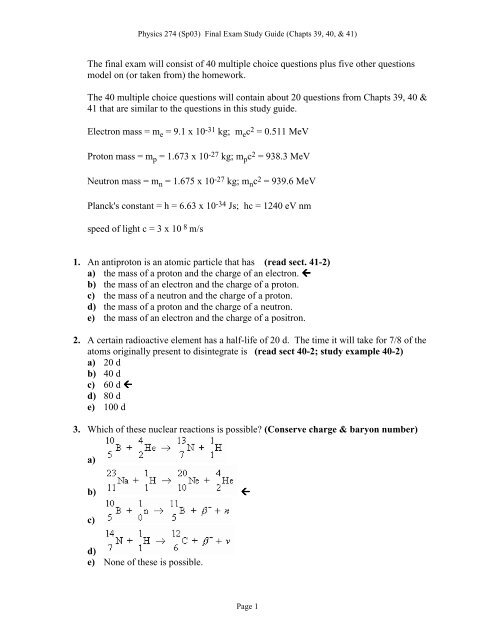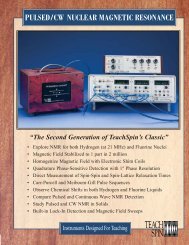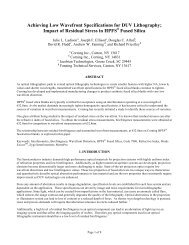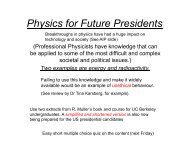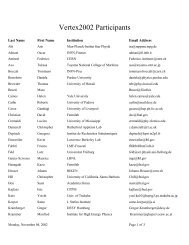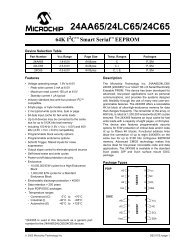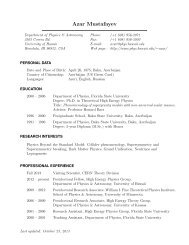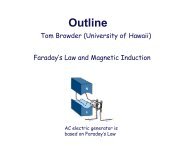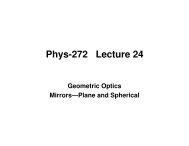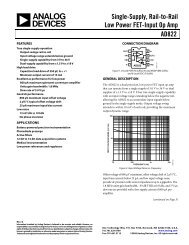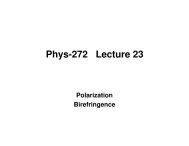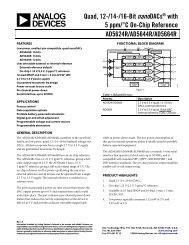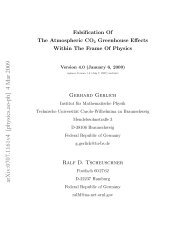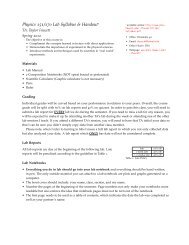(with correct answers indicated by arrows) for the final exam.
(with correct answers indicated by arrows) for the final exam.
(with correct answers indicated by arrows) for the final exam.
Create successful ePaper yourself
Turn your PDF publications into a flip-book with our unique Google optimized e-Paper software.
Physics 274 (Sp03) Final Exam Study Guide (Chapts 39, 40, & 41)<br />
The <strong>final</strong> <strong>exam</strong> will consist of 40 multiple choice questions plus five o<strong>the</strong>r questions<br />
model on (or taken from) <strong>the</strong> homework.<br />
The 40 multiple choice questions will contain about 20 questions from Chapts 39, 40 &<br />
41 that are similar to <strong>the</strong> questions in this study guide.<br />
Electron mass = m e = 9.1 x 10 -31 kg; m e c 2 = 0.511 MeV<br />
Proton mass = m p = 1.673 x 10 -27 kg; m p c 2 = 938.3 MeV<br />
Neutron mass = m n = 1.675 x 10 -27 kg; m n c 2 = 939.6 MeV<br />
Planck's constant = h = 6.63 x 10 -34 Js; hc = 1240 eV nm<br />
speed of light c = 3 x 10 8 m/s<br />
1. An antiproton is an atomic particle that has (read sect. 41-2)<br />
a) <strong>the</strong> mass of a proton and <strong>the</strong> charge of an electron. !<br />
b) <strong>the</strong> mass of an electron and <strong>the</strong> charge of a proton.<br />
c) <strong>the</strong> mass of a neutron and <strong>the</strong> charge of a proton.<br />
d) <strong>the</strong> mass of a proton and <strong>the</strong> charge of a neutron.<br />
e) <strong>the</strong> mass of an electron and <strong>the</strong> charge of a positron.<br />
2. A certain radioactive element has a half-life of 20 d. The time it will take <strong>for</strong> 7/8 of <strong>the</strong><br />
atoms originally present to disintegrate is (read sect 40-2; study <strong>exam</strong>ple 40-2)<br />
a) 20 d<br />
b) 40 d<br />
c) 60 d !<br />
d) 80 d<br />
e) 100 d<br />
3. Which of <strong>the</strong>se nuclear reactions is possible? (Conserve charge & baryon number)<br />
a)<br />
b) !<br />
c)<br />
d)<br />
e) None of <strong>the</strong>se is possible.<br />
Page 1
Physics 274 (Sp03) Final Exam Study Guide (Chapts 39, 40, & 41)<br />
4. A conservation law that is not universal but applies only to certain kinds of interactions is<br />
conservation of (Read sect 41-3; study <strong>exam</strong>ple 41-3)<br />
a) lepton number<br />
b) baryon number<br />
c) spin<br />
d) charge<br />
e) strangeness !<br />
5. In quantum electrodynamics (QED), electromagnetic <strong>for</strong>ces are mediated <strong>by</strong><br />
(Read sect 41-5; study Table 41-4)<br />
a) <strong>the</strong> interaction of electrons.<br />
b) hadrons.<br />
c) action at a distance.<br />
d) <strong>the</strong> weak nuclear interaction.<br />
e) <strong>the</strong> exchange of virtual photons. !<br />
6. What are <strong>the</strong> numbers of protons Z and neutrons N in <strong>the</strong> missing fragment of <strong>the</strong><br />
following fission reaction? (Conserve charge and baryon number)<br />
a) Z = 55 and N = 37<br />
b) Z = 37 and N = 55 !<br />
c) Z = 92 and N = 37<br />
d) Z = 37 and N = 92<br />
e) Z = 37 and N = 58<br />
7. Conservation laws that describe events involving <strong>the</strong> elementary particles include <strong>the</strong><br />
conservation of (Read sect 41-3; study <strong>exam</strong>ples 41-2 & 41-3)<br />
a) energy.<br />
b) linear and angular momentum.<br />
c) electric charge.<br />
d) baryon and lepton numbers.<br />
e) All of <strong>the</strong>se are <strong>correct</strong>. !<br />
Page 2
Physics 274 (Sp03) Final Exam Study Guide (Chapts 39, 40, & 41)<br />
8. The energy released <strong>by</strong> <strong>the</strong> nuclear bomb that destroyed Hiroshima was equivalent to<br />
12.4 kilotons of TNT. This is equivalent to 9.0 × 10 26 MeV. The mass that was<br />
converted into energy in this explosion was (Convert MeV"Joules, use E=mc 2 )<br />
a) 1.6 kg<br />
b) 1.6 × 10 –3 kg !<br />
c) 1.4 × 10 14 kg<br />
d) 1.1 × 10 10 kg<br />
e) 120 kg<br />
9. Redshift measurements of a galaxy yield a recession of 1700 km/s. Hubble's constant H is<br />
23 km/s/10 6 c·y. The distance to <strong>the</strong> galaxy is approximately (Use Eqn 41-9)<br />
a) 36 × 10 6 c·y<br />
b) 47 × 10 6 c·y<br />
c) 53 × 10 6 c·y<br />
d) 66 × 10 6 c·y<br />
e) 74 × 10 6 c·y !<br />
10. A moderator is used to slow (Read sect 40-4, especially page 1300 )<br />
a) protons<br />
b) alpha particles<br />
c) neutrons !<br />
d) beta particles<br />
e) photons<br />
11. In <strong>the</strong> decay scheme (Conserve charge and electron lepton number)<br />
<strong>the</strong> blanks should contain<br />
a) β + and n<br />
b) β – and ν<br />
c) β – and p<br />
d) β + and ν !<br />
e) β + and β –<br />
Page 3
Physics 274 (Sp03) Final Exam Study Guide (Chapts 39, 40, & 41)<br />
12. An electron traveling at 0.980c has a total energy of (Use eqn 39-25)<br />
a) 0.245 MeV<br />
b) 0.511 MeV<br />
c) 0.756 MeV<br />
d) 1.736 MeV<br />
e) 2.55 MeV !<br />
13. The <strong>correct</strong> expression relating <strong>the</strong> energy E of a particle to its rest mass m 0 , its<br />
momentum p, and <strong>the</strong> speed of light c, is (see eqn 39-28)<br />
a) E 2 = p 2 c 2 + m 0 c 2<br />
b) E 2 = p 2 c 2 + (m 0 c) 2<br />
c) E 2 = p 2 c + (m 0 c 2 ) 2<br />
d) E 2 = pc 2 + (m 0 c 2 ) 2<br />
e) E 2 = p 2 c 2 + (m 0 c 2 ) 2 !<br />
14. Fission occurs because <strong>the</strong> average binding energy per nucleon <strong>for</strong> <strong>the</strong> fission fragments<br />
is higher than that <strong>for</strong> <strong>the</strong> original nucleus. The change in binding energy per nucleon is<br />
approximately (Stare at Figure 40-3 and/or 40-9)<br />
a) 0.20 MeV<br />
b) 1.0 MeV !<br />
c) 7.0 MeV<br />
d) 28 MeV<br />
e) 0.20 keV<br />
15. The charge of <strong>the</strong> particle dds is (Read sect 41-4; study table 41-2)<br />
a) e<br />
b) (1/3)e<br />
c) (–2/3)e<br />
d) –e !<br />
e) zero<br />
Page 4
Physics 274 (Sp03) Final Exam Study Guide (Chapts 39, 40, & 41)<br />
16. (Read sect 40-2, especially pg 1291)<br />
The beta spectrum <strong>for</strong> 12 B decay is shown in <strong>the</strong> graph. The kinetic energy of an emitted<br />
β particle is 6.00 MeV. The energy of <strong>the</strong> associated neutrino is approximately<br />
a) 6.00 MeV<br />
b) 13.4 MeV<br />
c) 7.40 MeV !<br />
d) 11.3 MeV<br />
e) 2.54 MeV<br />
17. The cosmic microwave background radiation is (Read sect 41-8, especially pgs 1330-<br />
31)<br />
a) radiation from <strong>the</strong> quasars that is redshifted.<br />
b) produced from processes going on all over <strong>the</strong> present universe.<br />
c) radiation from <strong>the</strong> Sun.<br />
d) radiation from <strong>the</strong> Big Bang that was around when electons and protons conbined to<br />
<strong>for</strong>m neutral hydrogen atoms. !<br />
e) radiation produced from electron-positron annihilation in <strong>the</strong> intergalatic regions.<br />
18. According to Hubble's law, <strong>the</strong> age of <strong>the</strong> universe is (Read sect 41-8, especially p1329)<br />
a) approximately 6000 years.<br />
b) less than 6000 years.<br />
c) roughly 1 billion years.<br />
d) too great to estimate.<br />
e) between 10 and 15 billion years. !<br />
Page 5
Physics 274 (Sp03) Final Exam Study Guide (Chapts 39, 40, & 41)<br />
19. The reaction µ – → e – +⎺ν e + ν µ conserves (Read sect 41-3)<br />
a) muon lepton number but not electron lepton number.<br />
b) electron lepton number but not muon lepton number.<br />
c) nei<strong>the</strong>r muon lepton nor electron lepton number.<br />
d) both muon and electron lepton numbers. !<br />
e) None of <strong>the</strong>se is <strong>correct</strong>.<br />
20.<br />
Two nuclides that are isotopes could lie on curve is (Read sect 40-1)<br />
a) 1<br />
b) 2 !<br />
c) 3<br />
d) 4<br />
e) 5<br />
21. The conservation law violated <strong>by</strong> <strong>the</strong> reaction p → π 0 + e + is <strong>the</strong> conservation of<br />
(Read sect 41-3)<br />
a) charge.<br />
b) energy.<br />
c) linear momentum.<br />
d) lepton number and baryon number. !<br />
e) angular momentum.<br />
Page 6
Physics 274 (Sp03) Final Exam Study Guide (Chapts 39, 40, & 41)<br />
22. Which of <strong>the</strong> following choices lists <strong>the</strong> four known types of <strong>for</strong>ces in nature in order of<br />
decreasing strength? (Study table 41-5)<br />
a) strong nuclear, electromagnetic, weak nuclear, gravitational !<br />
b) electromagnetic, strong nuclear, weak nuclear, gravitational<br />
c) strong nuclear, gravitational, weak nuclear, electromagnetic<br />
d) strong nuclear, weak nuclear, electromagnetic, gravitational<br />
e) strong nuclear, electromagnetic, gravitational, weak nuclear<br />
23. The nuclear radius of is approximately is (Use eqn 40-1)<br />
a) 1.05 fm<br />
b) 4.50 fm !<br />
c) 0.350 fm<br />
d) 11.2 fm<br />
e) 1.85 fm<br />
24. (Look at Fig 40-7 and think about differences between an α particle & a neutron)<br />
The graph that represents <strong>the</strong> interaction of <strong>the</strong> proton and neutron is<br />
a) 1<br />
b) 2<br />
c) 3<br />
d) 4<br />
e) 5 !<br />
Page 7
Physics 274 (Sp03) Final Exam Study Guide (Chapts 39, 40, & 41)<br />
25. Particles that participate in <strong>the</strong> strong nuclear interaction are called (Read sect 41-7)<br />
a) neutrinos<br />
b) hadrons !<br />
c) leptons<br />
d) electrons<br />
e) photons<br />
26. Current thought is that all matter is composed of is (Read sect 41-4, study table 41-3)<br />
a) six quarks.<br />
b) four quarks and four leptons.<br />
c) six leptons.<br />
d) six quarks and four leptons.<br />
e) six quarks and six leptons. !<br />
27. The fact that <strong>the</strong> binding energy per nucleon is roughly a constant over most of <strong>the</strong> range of<br />
stable nuclei is a consequence of <strong>the</strong> fact that <strong>the</strong> nuclear <strong>for</strong>ce is (Read sect 40-1,<br />
especially p1288)<br />
a) short range. !<br />
b) long range.<br />
c) weak.<br />
d) strong.<br />
e) repulsive.<br />
28. A particle moves in such a way that its kinetic energy just equals its rest energy. The<br />
velocity of this particle is ( Use Eqn 39-23)<br />
a) 0.866c !<br />
b) c/4<br />
c) c<br />
d) 0.707c<br />
e) c/2<br />
29. The total yearly world consumption of energy is approximately 4.0 × 10 20 J. How much<br />
mass would have to be completely converted into energy to provide this amount of<br />
energy? (Use E=mc 2 )<br />
a) 4.4 × 10 3 kg<br />
b) 1.3 × 10 12 kg<br />
c) 1.3 × 10 4 kg !<br />
d) 4.4 × 10 5 kg<br />
e) 2.2 × 10 4 kg<br />
Page 8
Physics 274 (Sp03) Final Exam Study Guide (Chapts 39, 40, & 41)<br />
30. Ru<strong>the</strong>r<strong>for</strong>d's experiments, in which he bombarded a very thin gold foil <strong>with</strong> alpha<br />
particles, showed that is (Read sect 37-1)<br />
a) all of <strong>the</strong> α particles passed through <strong>the</strong> foil <strong>with</strong>out significant deflection.<br />
b) none of <strong>the</strong> α particles were able to penetrate <strong>the</strong> foil.<br />
c) all of <strong>the</strong> α particles passed through <strong>the</strong> foil and were deflected through large angles.<br />
d) most of <strong>the</strong> α particles passed through <strong>the</strong> foil <strong>with</strong> negligible deflection but some<br />
were deflected through large angles. !<br />
e) <strong>the</strong> α particles were linearly polarized after passing through <strong>the</strong> foil.<br />
31. The interaction that describes <strong>the</strong> <strong>for</strong>ces among nucleons that hold nuclei toge<strong>the</strong>r is is<br />
(Read sect 40-1)<br />
a) <strong>the</strong> strong nuclear (hadronic) interaction. !<br />
b) <strong>the</strong> electromagnetic interaction.<br />
c) <strong>the</strong> weak nuclear interaction.<br />
d) <strong>the</strong> gravitational interaction.<br />
e) None of <strong>the</strong>se is <strong>correct</strong>.<br />
32. The following fusion reaction occurs in <strong>the</strong> sun: is (Read sect 40-3, study <strong>exam</strong>. 40-5)<br />
The masses of <strong>the</strong> nuclei are<br />
3He = 3.016 049 u<br />
4He = 4.002 604 u<br />
7Be = 7.016 930 u<br />
The energy released or absorbed <strong>by</strong> <strong>the</strong> reaction is<br />
a) 920 MeV, absorbed<br />
b) 1.6 MeV, absorbed !<br />
c) 920 MeV, released<br />
d) 1.6 MeV, released<br />
e) 270 MeV, released<br />
Page 9
Physics 274 (Sp03) Final Exam Study Guide (Chapts 39, 40, & 41)<br />
Page 10


